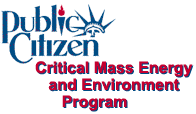

The Nuclear Industry: A Cash Cow for Congress II
Polluter PAC
Contributions, Radioactive Waste Disposal,
and the House of
Representatives
April 1999
Auke Piersma
Jamie Willmuth
Copyright 1999 by Public Citizen. All rights reserved. No part of this document may be reproduced or utilized in any form or by any means electronic or mechanical, including photography, recording or by information storage and retrieval system, without written permission from the authors.
Public Citizen is a nonprofit membership organization in Washington, D.C., dedicated to advancing consumer rights through lobbying, litigation, research, publications and information services. Since its founding by Ralph Nader in 1971, Public Citizen has fought for consumer rights in the marketplace, for safe and secure health, for fair trade, for clean and safe energy sources, and for corporate and government accountability. Critical Mass Energy Project is its energy policy group.
The Nuclear Industry: A
Cash Cow for Congress II
Polluter PAC Contributions, Radioactive Waste
Disposition, and the House of Representatives
The nuclear industry is doling out money to the members of the House of Representatives as they prepare to vote on H.R. 45, the Nuclear Waste Policy Act of 1999, an anti-environmental bill that will have major environmental, health and safety consequences for the citizens of this nation. An analysis of political action committee (PAC) contributions from corporations, labor groups, and other organizations who are members the Nuclear Energy Institute (NEI), the lobbying arm of the nuclear industry, show that these groups gave almost $15.5 million dollars to current members of Congress in the 1998 election cycle. The leading recipients of contributions from the nuclear industry are those Representatives who supported H.R. 1270, a similar bill in the last Congress. Meanwhile, the political parties have accepted $3.7 million in soft money from NEI and its membership since 1997.
|
Campaign Contributions from the Nuclear Industry (1997 - 1998) | |
| House PACs |
$8,546,913 |
| Senate PACs |
$3,206,585 |
| Soft Money |
$3,718,250 |
| Total |
$15,471,748 |
H.R. 45 - The Nuclear Waste Policy Act of 1999
The nuclear industry has turned to the 106th Congress, hoping to achieve its longstanding goal of having the federal government bail it out and take away its toxic trash. The industry is attempting to sell the irresponsible H.R. 45 as the ultimate solution for high level nuclear waste. In reality, the bill rolls back health and safety standards, while forcing the transport of deadly nuclear waste across the country.
The nuclear industry has only one reason to push for the passage of H.R. 45. The industry wants to solve its public relations problems by compelling American taxpayers to finance a scheme that moves waste from reactors to Nevada. However, moving the waste is more expensive and dangerous than leaving it on-site until a better option can be found. Once again, the nuclear industry is looking for another costly subsidy, whose risks to the public far outweigh the benefits.
H.R. 45 makes our nationís current illogical nuclear waste polices worse. The legislation continues the poor U.S. policy of burying nuclear waste in a dump that will have to be cleaned up in the future at an unimaginable cost to taxpayers. At the same time, the bill weakens our most critical environmental protections.
|
Commercial Atomic Waste Commercial atomic waste is extremely dangerous and it remains hazardous for at least 1,000,000 years. A person standing one yard away from an unshielded, 10-year-old fuel assembly would receive a lethal dose of radiation (500 rem) in less than three minutes. A thirty-second exposure (100 rem) would significantly increase the risk of cancer or genetic damage. |
Radioactive Payoff in the House
It is no accident that the House of Representatives is poised to impose on the citizens of this nation a dangerous and costly "solution" for the nuclear waste problem. In the 1998 election cycle, NEI members contributed $8.5 million to the members of the House as they passed H.R. 1270 (a 306 to 120 vote). Not surprisingly, there is a direct correlation between members of the House who voted with the nuclear industry and the industryís campaign contributions. Of the $8.5 million to members of the House, $6.4 million (75%) flowed to those who supported the legislation. The members of House who supported the legislation on average collected $23,084, which is $7,490 more than the average $15,594 received by those who opposed the bill. While PAC money naturally flows toward those members who already endorse the industry position, it undoubtedly helps to consolidate that support and influence undecided votes.

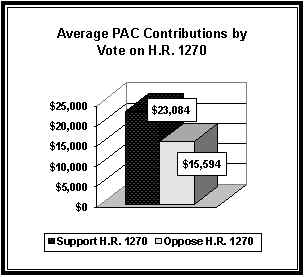
|
Nuclear Energy Institute: Voice for the Nuclear Industry NEI, with an annual operating budget of $26.5 million, was born from the 1994 merger of four separate nuclear organizations. It bills itself as the nuclear industryís unified policy voice, but it is also the chief architect of the nuclear industryís lobbying strategy. Membership in NEI includes the nuclear utilities, the designers of nuclear plants, like Westinghouse and General Electric, labor groups and universities. In its 1998 annual report, NEI brags about garnering support for H.R. 1270 from 70% of Congress. NEI developed the lobbying tactics, and both NEI and its members provided the campaign contributions to achieve strong support for the nuclear waste bill. Many of NEIís members spent time and effort lobbying on behalf of H.R. 1270. |
Committee on Commerce: Where the Money Flows
The Commerce Committee has principal jurisdiction over H.R. 45. Not so surprisingly, the industry ensured a substantial flow of contributions to the members of the committee. The committee members on average received $33,824, $16,096 more than members of the House not on the Commerce Committee. The subcommittee with jurisdiction over H.R. 45 is the Subcommittee on Energy and Power. Subcommittee members on average received a whopping $39,546, $21,380 more than members of the House not on the subcommittee.
The substantial flow of money to the Commerce Committee centered on supporting committee members who voted for final passage of H.R. 1270. These committee members accepted $38,566 on average. This is $23,216 more than the committee members who opposed the bill.
At the subcommittee level, the correlation between PAC contributions and supporters of the nuclear industry continues. Subcommittee members who voted for H.R. 1270 accepted $44,055 on average. These supporters received $20,505 more than subcommittee members who opposed the bill.
Finally, the Commerce Committee leadership has been a leading beneficiary of nuclear industry and its money. Committee Chairman Thomas Bliley (R-VA), who is trying to shepherd H.R. 45 through the committee, received $80,681. Energy and Power Subcommittee Chair Joe Barton (R-TX), a leading advocate for the industry, was the recipient of $117,744. Ranking Member John Dingell, who received $111,632, and Subcommittee Ranking Member Ralph Hall, who received $68,123, both support the bill.
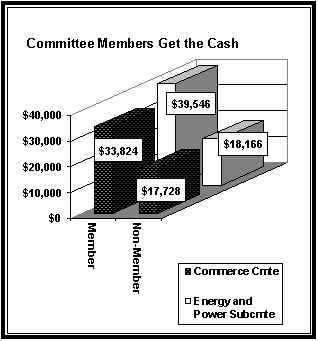
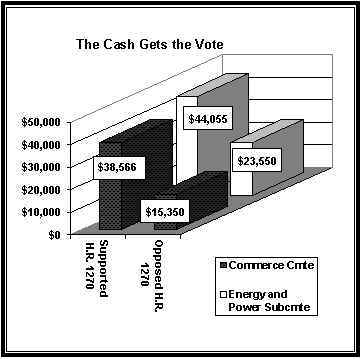
NEI Members
Contributions:
Higher Dollars for So-Called "Environmental
Congressmen"
NEI has been especially successful in influencing the votes of those members rated highly by the League of Conservation Voters (LCV) for their environmental votes. LCV, the bipartisan, political arm of the national environmental movement, details the voting records of members of Congress on environmental legislation. Members of Congress who generally vote "green," but who support the nuclear industryís waste bill, received large campaign contributions from the nuclear industry and its supporters.
There are currently 75 members of Congress who have an LCV score greater than 85 (they voted to protect the environment for at least 85% of the time). Of these members, 21 of them voted for H.R. 1270, in part because of the large contributions they received (see table below). Those 21 members received an average of $24,009 in PAC contributions, $10,922 more than the "green" members who opposed the bill.
Representative John Olver (D-MA) would have scored a perfect 100 in voting to protect the environment. Instead he voted to remove environmental protections and legislate a dangerous nuclear waste policy while accepting $23,500 from the nuclear industry. To be fair, his district contains a reactor that has permanently shut down. However, other members whose districts also contain reactors that have permanently shut down recognized the dangers of this bill and voted against it.
Other environmentally inclined House members who received large campaign contributions (>$20,000) from NEI membership and subsequently voted with the industry are: Sherrod Brown (D-OH), Sam Gejdenson (D-CT), Constance Morella (R-MD), Edolphus Towns (D-NY), Thomas Sawyer (D-OH), Robert Matsui (D-CA), Karen McCarthy (D-MO), Bobby Rush (D-IL), Nancy Johnson (R-CT), and Sander Levin (D-MI). These members, who voted against the public interest, have cultivated an image of either "peopleís advocate" or "protector of the environment" in their districts. Like Representative Olver, they too have their excuses, but none override the fact that this bill will bring more risk to their constituents. The following table contains all 21 House members who have LCV scores greater than 85 and yet voted in favor of H.R. 1270.
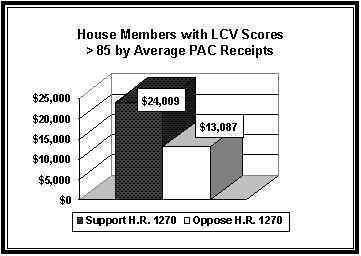
|
Members of Congress
with LCV scores of >85 | |||||||
|
LCV |
ST |
DIST |
P |
FIRST |
LAST |
H.R.1270 |
Total
NEI |
|
97 |
MA |
01 |
D |
John W. | Olver |
Support |
$23,500 |
|
93 |
CT |
02 |
D |
Sam | Gejdenson |
Support |
$21,250 |
|
93 |
MA |
02 |
D |
Richard E. | Neal |
Support |
$16,550 |
|
93 |
MD |
08 |
R |
Constance A. | Morella |
Support |
$27,000 |
|
93 |
ME |
01 |
D |
Thomas H. | Allen |
Support |
$19,000 |
|
93 |
NJ |
13 |
D |
Robert | Menendez |
Support |
$15,500 |
|
93 |
OH |
13 |
D |
Sherrod | Brown |
Support |
$48,969 |
|
90 |
FL |
19 |
D |
Robert | Wexler |
Support |
$6,750 |
|
90 |
MA |
04 |
D |
Barney | Frank |
Support |
$2,000 |
|
90 |
MN |
04 |
D |
Bruce F. | Vento |
Support |
$14,450 |
|
90 |
NY |
04 |
D |
Carolyn | McCarthy |
Support |
$17,500 |
|
90 |
NY |
10 |
D |
Edolphus | Towns |
Support |
$41,950 |
|
90 |
NY |
14 |
D |
Carolyn | Maloney |
Support |
$10,500 |
|
90 |
NY |
17 |
D |
Eliot L. | Engel |
Support |
$10,500 |
|
86 |
CA |
05 |
D |
Robert T. | Matsui |
Support |
$32,359 |
|
86 |
CT |
06 |
R |
Nancy L. | Johnson |
Support |
$44,609 |
|
86 |
IL |
01 |
D |
Bobby L. | Rush |
Support |
$26,862 |
|
86 |
MI |
12 |
D |
Sander M. | Levin |
Support |
$34,000 |
|
86 |
MN |
06 |
D |
Bill | Luther |
Support |
$18,741 |
|
86 |
MO |
05 |
D |
Karen | McCarthy |
Support |
$20,750 |
|
86 |
OH |
14 |
D |
Thomas C. | Sawyer |
Support |
$51,450 |
|
H.R. 45, An Environmental Disaster in the Making H.R. 45 is a drastic rollback of environmental protections for nuclear waste disposition. The bill prohibits the Environmental Protection Agency (EPA) from issuing radiation release standards to protect the public. Instead, H.R. 45 sets a standard that allows individuals to receive four times as much radiation as permitted by current regulations for nuclear waste storage facilities. H.R. 45 revokes current regulations for Yucca Mountain that if properly applied, would disqualify Yucca Mountain as a nuclear waste repository. H.R. 45 preempts all federal, state and local laws that are "inconsistent" with the legislation. This includes the Safe Drinking Water Act and any state legislation that would provide extra protections for its citizens. |
|
Atomic Transport H.R. 45 will require that over the next 30 years, 100,000 shipments of radioactive waste be moved through 43 states exposing 50 million Americans to the perils of nuclear waste transport. Department of Transportation statistics show that once shipments begin, accidents are unavoidable. Nearly 100,000 hazardous material accidents occurred on roads and rails in the past 10 years. These accidents caused $300 million in damages and over 100 deaths. It is estimated that 210 to 354 nuclear waste accidents could result in the 30 year shipping campaign mandated by H.R. 45. A small rural accident could contaminate a 42 square mile area, require 462 days to clean up, and cost $620 million. |
Conclusion - The Buy-Off is Happening, Only Constituents Can Stop It
NEI members, with their vested economic interest in passing H.R. 45, have showered key members of Congress with campaign contributions. The nuclear industryís buying of Congress is another example of corporate special interests influencing the legislative process during the 106th Congress. But it doesnít stop there. NEI and its members also showered the political parties with soft money. This is unacceptable.
But even more deplorable is a situation where elected officials are for sale. Our current campaign finance system allows special interests to buy access to our elected officials. This access is rare for ordinary citizens. Citizens across the country must say no to this corruption of our democracy. It is time to hold our elected representatives accountable and through an organized voting block to refuse reelection of the members of Congress who vote against the interests of their constituents. Citizens must demand that later this session, when the House votes on H.R. 45, their member of Congress votes against this selfish and dangerous scheme to transport waste through 43 states over 30 years. Itís time to take back the Congress for the people. Stopping the nuclear industryís greedy scheme is a good place to start.
Methodology
All contribution figures were compiled from Federal Election Commission data and include contributions by the Nuclear Energy Institute and its membership in the United States. The Nuclear Energy Institute member list was taken from the Nuclear Energy Institute 1998 Annual Report. PAC totals reflect the amount given by PACs in the 1997-1998 election cycle (Jan.1, 1997-Dec. 31, 1998). Soft money totals were complied from data made available by Common Cause (http://www.commoncause.org)/.
Auke Piersma, energy policy analyst at Public Citizenís Critical Mass Energy Project, was the principal author of this report. Jamie Willmuth, senior researcher at Public Citizenís Congress Watch, provided research and significant conceptual and editorial advice.
Appendix I: Members of NEI whose PACs Contributed to the 106th House Members
Appendix II: NEI PAC Contributions to the Top 50 Members of the 106th Congress
Appendix III: NEI PAC Contributions to Members of the 106th Congress by State